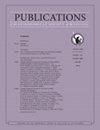用于下一代光谱学的多放大器传感电荷耦合器件
IF 7.7
3区 物理与天体物理
Q2 ASTRONOMY & ASTROPHYSICS
Publications of the Astronomical Society of the Pacific
Pub Date : 2024-09-06
DOI:10.1088/1538-3873/ad716c
引用次数: 0
摘要
我们介绍了具有 16 个通道的多放大器传感(MAS)硅电荷耦合器件(CCD)传感器原型的特性分析结果和性能,该传感器可能适用于微弱天体天文光谱分析和低信号、光子限制成像。MAS CCD 的设计目的是在串行传输位移过程中通过一系列放大器重复测量电荷,从而达到亚电子级读出噪声。通过使用基于暗能量光谱仪 CCD 控制器的同步读出电子装置,我们发现在 26 μs pix-1 的速度下,读出噪声为 1.03 e- rms pix-1,并且采用了单采样读出方案,即每个输出级只测量一次像素中的电荷。在这些工作参数下,我们发现所有放大器在低计数时的放大器到放大器电荷转移效率(ACTE)均为 0.9995,只有一个放大器的 ACTE 为 0.997。对于我们为串行时钟和栅极选择的读取噪声优化电压配置,电荷转移效率低于 50,000 电子。此外,在 300 至 35,000 个电子的宽动态范围内,测量到的放大器线性度为 ±2.5%。我们介绍了在这些特性上进行优化的关键操作参数,并描述了 MAS CCD 可作为候选探测器的具体应用。本文章由计算机程序翻译,如有差异,请以英文原文为准。
Multi-amplifier Sensing Charge-coupled Devices for Next Generation Spectroscopy
We present characterization results and performance of a prototype Multiple-Amplifier Sensing (MAS) silicon charge-coupled device (CCD) sensor with 16 channels potentially suitable for faint object astronomical spectroscopy and low-signal, photon-limited imaging. The MAS CCD is designed to reach sub-electron readout noise by repeatedly measuring charge through a line of amplifiers during the serial transfer shifts. Using synchronized readout electronics based on the Dark Energy Spectroscopic Instrument CCD controller, we report a read noise of 1.03 e− rms pix−1 at a speed of 26 μ s pix−1 with a single-sample readout scheme where charge in a pixel is measured only once for each output stage. At these operating parameters, we find the amplifier-to-amplifier charge transfer efficiency (ACTE) to be >0.9995 at low counts for all amplifiers but one for which the ACTE is 0.997. This charge transfer efficiency falls above 50,000 electrons for the read-noise optimized voltage configuration we chose for the serial clocks and gates. The amplifier linearity across a broad dynamic range from ∼300 to 35,000 e− was also measured to be ±2.5%. We describe key operating parameters to optimize on these characteristics and describe the specific applications for which the MAS CCD may be a suitable detector candidate.
求助全文
通过发布文献求助,成功后即可免费获取论文全文。
去求助
来源期刊
CiteScore
6.70
自引率
5.70%
发文量
103
审稿时长
4-8 weeks
期刊介绍:
The Publications of the Astronomical Society of the Pacific (PASP), the technical journal of the Astronomical Society of the Pacific (ASP), has been published regularly since 1889, and is an integral part of the ASP''s mission to advance the science of astronomy and disseminate astronomical information. The journal provides an outlet for astronomical results of a scientific nature and serves to keep readers in touch with current astronomical research. It contains refereed research and instrumentation articles, invited and contributed reviews, tutorials, and dissertation summaries.

 求助内容:
求助内容: 应助结果提醒方式:
应助结果提醒方式:


